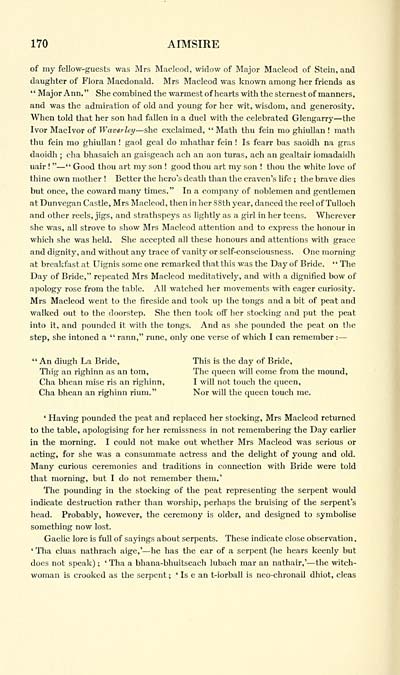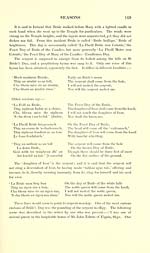Blair Collection > Carmina gadelica > Volume 1
(212)
Download files
Complete book:
Individual page:
Thumbnail gallery: Grid view | List view

170 AIMSIRE
of my fellow-guests was Mrs Macleod, widow of Major Macleod of Stein, and
daughter of Flora Macdonald. Mrs Macleod was known among her friends as
" Major Ann." She combined the warmestof hearts with the sternest of manners,
and was the admiration of old and young for her wit, wisdom, and generosity.
When told tliat her son had fallen in a duel with the celebrated Glengarry — the
Ivor Maclvor of Waverley — she exclaimed, " Math thu fein mo ghiullan ! math
thu fein mo ghiullan ! gaol geal do mhathar fein ! Is fearr bas saoidh na gras
daoidh ; cha bhasaich an gaisgeach ach an aon turas, ach an gealtair iomadaidh
uair ! " — " Good thou art my son ! good thou art my son ! thou the white love of
thine own mother ! Better the hero's death than the craven's life ; the brave dies
but once, the coward many times." In a company of noblemen and gentlemen
at Dunvegan Castle, Mrs Macleod, then in her 88th year, danced the reel of Tulloch
and other reels, jigs, and sti-athspcys as lightly as a girl in her teens. Wherever
she was, all strove to show Mrs Macleod attention and to express the honour in
which she was held. She accepted all these honours and attentions with grace
and dignity, and without any trace of vanity or self-consciousness. One morning
at breakfast at Uignis some one remarked that this was the Day of Bride. " The
Day of Bride," repeated Mrs Macleod meditatively, and with a dignified bow of
apology rose from the table. All watched her movements with eager curiosity.
Mrs Macleod went to the fireside and took up the tongs and a bit of peat and
walked out to the doorstep. She then took off her stocking and put the peat
into it, and pounded it with the tongs. And as she pounded the peat on the
step, she intoned a " rann," rune, only one verse of which I can remember : —
" An diugh La Bride, This is the day of Bride,
Thig an righinn as an torn. The queen mil come from the mound,
Cha bhean mise ris an righinn, I will not touch the queen,
Cha bhean an righinn rium." Nor will the queen touch me.
' Having pounded the peat and replaced her stocking, Mrs Macleod returned
to the table, apologising for her remissness in not remembering the Day earlier
in the morning. I could not make out whether Mrs Macleod was serious or
acting, for she was a consummate actress and the delight of young and old.
Many curious ceremonies and traditions in connection with Bride were told
that morning, but I do not remember them.'
The pounding in the stocking of the peat representing the serpent would
indicate destruction rather than worship, perhaps the bruising of the serpent's
head. Probably, however, the ceremony is older, and designed to symbolise
something now lost.
Gaelic lore is full of sayings about serpents. These indicate close observation .
' Tha cluas nathrach aige,' — he has the ear of a serpent (he hears keenly but
does not speak) ; ' Tha a bhana-bhuitseach lubach mar an nathair,' — the witch-
woman is crooked as the serpent ; ' Is e an t-iorball is neo-chronail dhiot, cleas
of my fellow-guests was Mrs Macleod, widow of Major Macleod of Stein, and
daughter of Flora Macdonald. Mrs Macleod was known among her friends as
" Major Ann." She combined the warmestof hearts with the sternest of manners,
and was the admiration of old and young for her wit, wisdom, and generosity.
When told tliat her son had fallen in a duel with the celebrated Glengarry — the
Ivor Maclvor of Waverley — she exclaimed, " Math thu fein mo ghiullan ! math
thu fein mo ghiullan ! gaol geal do mhathar fein ! Is fearr bas saoidh na gras
daoidh ; cha bhasaich an gaisgeach ach an aon turas, ach an gealtair iomadaidh
uair ! " — " Good thou art my son ! good thou art my son ! thou the white love of
thine own mother ! Better the hero's death than the craven's life ; the brave dies
but once, the coward many times." In a company of noblemen and gentlemen
at Dunvegan Castle, Mrs Macleod, then in her 88th year, danced the reel of Tulloch
and other reels, jigs, and sti-athspcys as lightly as a girl in her teens. Wherever
she was, all strove to show Mrs Macleod attention and to express the honour in
which she was held. She accepted all these honours and attentions with grace
and dignity, and without any trace of vanity or self-consciousness. One morning
at breakfast at Uignis some one remarked that this was the Day of Bride. " The
Day of Bride," repeated Mrs Macleod meditatively, and with a dignified bow of
apology rose from the table. All watched her movements with eager curiosity.
Mrs Macleod went to the fireside and took up the tongs and a bit of peat and
walked out to the doorstep. She then took off her stocking and put the peat
into it, and pounded it with the tongs. And as she pounded the peat on the
step, she intoned a " rann," rune, only one verse of which I can remember : —
" An diugh La Bride, This is the day of Bride,
Thig an righinn as an torn. The queen mil come from the mound,
Cha bhean mise ris an righinn, I will not touch the queen,
Cha bhean an righinn rium." Nor will the queen touch me.
' Having pounded the peat and replaced her stocking, Mrs Macleod returned
to the table, apologising for her remissness in not remembering the Day earlier
in the morning. I could not make out whether Mrs Macleod was serious or
acting, for she was a consummate actress and the delight of young and old.
Many curious ceremonies and traditions in connection with Bride were told
that morning, but I do not remember them.'
The pounding in the stocking of the peat representing the serpent would
indicate destruction rather than worship, perhaps the bruising of the serpent's
head. Probably, however, the ceremony is older, and designed to symbolise
something now lost.
Gaelic lore is full of sayings about serpents. These indicate close observation .
' Tha cluas nathrach aige,' — he has the ear of a serpent (he hears keenly but
does not speak) ; ' Tha a bhana-bhuitseach lubach mar an nathair,' — the witch-
woman is crooked as the serpent ; ' Is e an t-iorball is neo-chronail dhiot, cleas
Set display mode to: Large image | Transcription
Images and transcriptions on this page, including medium image downloads, may be used under the Creative Commons Attribution 4.0 International Licence unless otherwise stated. ![]()
| Early Gaelic Book Collections > Blair Collection > Carmina gadelica > Volume 1 > (212) |
|---|
| Permanent URL | https://digital.nls.uk/75762002 |
|---|
| Attribution and copyright: |
|
|---|---|
| Description | A selection of books from a collection of more than 500 titles, mostly on religious and literary topics. Also includes some material dealing with other Celtic languages and societies. Collection created towards the end of the 19th century by Lady Evelyn Stewart Murray. |
|---|
| Description | Selected items from five 'Special and Named Printed Collections'. Includes books in Gaelic and other Celtic languages, works about the Gaels, their languages, literature, culture and history. |
|---|

